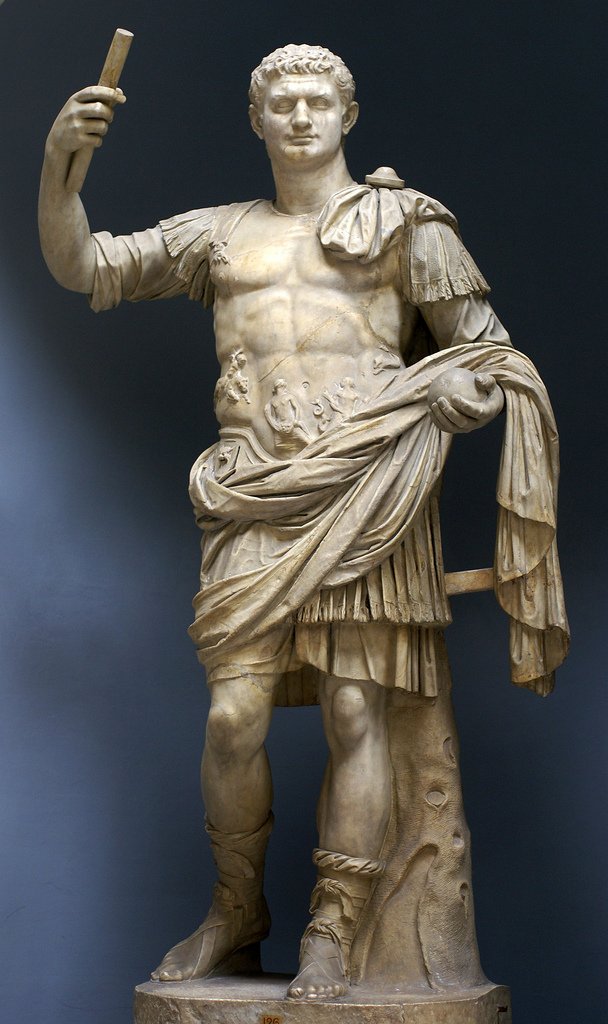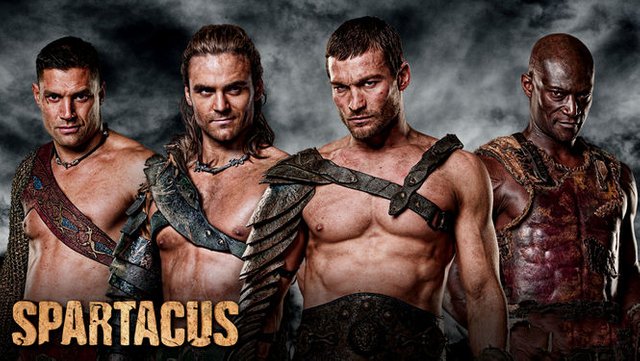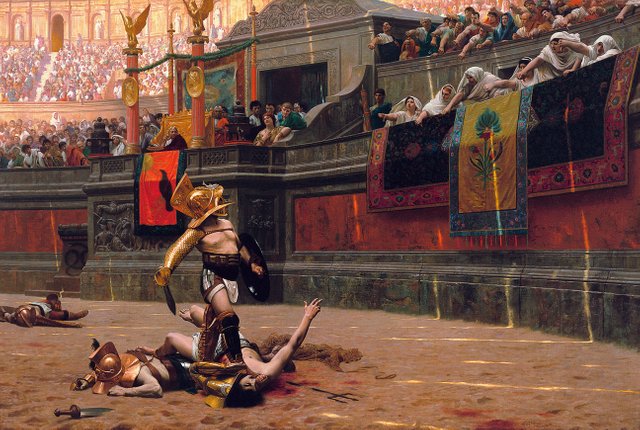The Gladiatorial Games: How Far Have We Come?
Lasting for over six hundred years, the gladiatorial games were one of humanity's most brutal forms of entertainment in a “civilized” society. This essay will explore the history of the games from beginning to end, the creative influence of the games, the different types of gladiators, and some misconceptions associated with the games.
Originally, the idea of forcing prisoners to fight to the death came from the Etruscans as early as the third century BC. “In 105 BC, for the first time, the two consuls of the year gave gladiator games officially.”
The Etruscans saw gladiatorial games as a form of religious human sacrifice to commemorate an important person's death whether it be the king, the king's nephew, or any other relative that was important enough to warrant the ceremonial bloodsport.
Following the adoption of the games by the Romans the games lost their sense of religious undertones. In the gladiatorial games, people fought not only against each other but also against animals such as lions, tigers, bears, ostriches, and anything else they could capture and kill in public.
It made the Colosseum double as a circus and zoo... except that the animals die at the end of the show. People who fought animals were known as bestiarii and these types of fights were much more popular and cheaper.
Later on Christians became fodder for the animals since they were the largest group within Rome who opposed the games and other Roman traditions. This act of using them as fodder ultimately led to the end of the games.

Constantine, as a Christian emperor, banned the games in 326 AD with an edict declaring that any prisoners who would have previously been sentenced to the gladiator games would instead be sent to perform hard labor, usually in the mines which some prisoners viewed as worse.
This edict was said to have been issued due to the pressure from the Fathers of the Church. Not everyone agreed with Constantine and the games persisted until 681 AD when the games officially dissipated. Although Christianity is not the only reason for the abolition of the games, it was the primary one.
For generations, the Roman empire designed amazing architectural feats in order to create more complex and grandiose arenas in which to view the slaughter of slaves, freemen, prisoners, and animals.
The Colosseum, one of the ancient wonders of the world, was opened to the public in 79AD and was called the Flavian Amphitheater named after the Flavian dynasty after the death of Nero.

The Colosseum held up to 80,000 spectators and stood 160 feet high. The local Roman population only took up a fraction of the seating and were allowed free entry while the other seats were paid by visitors who came to see the most epic fights in the best arena known to man.

To celebrate its opening, Emperor Titus hosted 100 straight days of gladiatorial games where over 9,000 beasts were slaughtered. Trajan gave 122 days of games where reportedly 11,000 people and 10,000 animals were killed. Fighters and animals would sometimes be raised from beneath the arena by using human powered elevator lifts, making the new combatants appear out of nowhere.

The games were heavily advertised by heralds, men carrying banners, stop-press supplements, and programs listing the upcoming fights. One discovered advertisement pointed out that, “the amphitheater’s opportunities for love-making, suggested the borrowing of a programme as a good way to strike up an acquaintance.” In modern layman’s terms, “Buy a program! Witness a murder! Get laid!”
By attending the games the audience was not only witnessing a sporting event but also a political one. The common peasant would sit in the same arena as the emperor and evaluate the character of their leader.
As mentioned in Gladiator Games: The Roman Bloodsport, the audience may ask themselves, “Is he actually a responsible man who ought to be an emperor or is he a beast? Has he got cruelty built into him? Is he enjoying it too much?” This would be comparable to watching the Democratic or Republican candidates watching the Superbowl.
There were a variety of different types of gladiator distinguished by their different fighting styles, weapons, and armor, and these occasionally coincided with the gladiators' nation of origin. “Foreign prisoners were made to fight with their own weapons and in their own styles.”
The Samnites, Gauls, and Thracians made up a significant amount of the gladiator nationalities. Thracians and Gauls were known well for their resistance to Romanization. The myrmillos, retiarii, securtores, and dimachaeri were popular fighting styles.
The Samnites would be equipped with a large shield, a metal greave on their left leg, a helmet with a visor, a sleeve on the right arm, and either a sword or lance. The Samnite fighting style and adornment was later regarded as securtores or “chasers”. It is often believed that gladiatorial games were fair fights, a man with a sword and shield against another man with a sword and shield but that was not always the case.
Match ups between heavily armored/low mobility fighters such as the myrmillo would fight low armored/high mobility fighters who wielded a net and trident such as the retiarius. This particular match up was themed because the myrmillo wore helmets with a fish emblem while the galeri (shoulder piece) of the retiarius was “decorated with a crab, a dolphin, and an anchor. These symbols recall that the retiarius was equipped after the manner of a fisherman; that is why a myrmillo, or fish-man, was a suitable adversary for him as an alternative to the secutor.”

The female fighter, otherwise known as a gladiatrix, was introduced in 63 AD and would typically fight with at least one bare breast. In 200 AD, Septimus Seberus banned women from fighting in the games.
Emperor Caligula was such a huge supporter of the Thracian fighters that he not only trained as one himself but also went as far as to employ Thracian gladiators as officers for his bodyguard. Caligula also reduced the amount of armor allowed to myrmillones and poisoned one myrmillo in particular, named Columbus.
Titus was another emperor that favored the Thracian fighting style and while he would argue their supremacy he knew better than to lose his sense of justice at the games. Titus' brother Domitian violently argued on the side of the myrmillo, sentencing a citizen to be “torn to pieces by dogs in the arena” for speaking ill of the myrmillo. This would be the equivalent to George W. Bush ordering the lethal injection of someone for mentioning how poorly the Cowboys had played during his time in office.
There are several misconceptions about the gladiatorial games. One popular misconception about the games is that the gladiators always fought to the death. Most of the owners of popular gladiators had too much money invested into their gladiator's training and upkeep to allow them to die. Nevertheless, it was considered shameful for a gladiator to ask for mercy.
In fact, the sponsor of the games, influenced by the crowds reaction, choose the fate of the fallen fighter. A gladiator was seen as having higher honor if he was to tilt his head back and expose his throat after defeat. Another misconception was the notion that a thumbs up from the audience meant that a fallen fighter should be given mercy.

This assumption is based on a single painting by Jean-Léon Gérôme in 1872 titled Pollice Verso or “Thumbs Down”. According to Gladiator Games: The Roman Bloodsport, this painting gained such popularity that most people believe that the thumbs down gesture is the definitive sign for death or execution although it may have actually been a side turned thumb or thumbs up.
Another popular misconception is that every gladiator was a slave or prisoner. Some Romans who were in over their head with debt, or trying to avoid becoming conscripted into the Roman army (who required a 25 year term of service), or people who wanted a chance to make twelve times the annual average income.
Some people became gladiators for the perks. For example, although they were seen as lower class human beings, gladiators were also seen as sex symbols and highly sought after by women in powerful positions. Prostitutes and sex slaves were also awarded to winners as incentives. The gladiators were also allowed to keep a portion of their winnings to buy whatever they wanted, including their freedom. Fan clubs and action figures of gladiators were not uncommon for those who rose in the ranks.
At first it appears impressive to see how far we have come in terms of our treatment of other humans since the end of the games. At the same time it is easy to see how the games drew such big crowds given our love of bloodshed and because, let's face it, for whatever reason, it is cool to see someone get their head cut off.
People have always been fascinated by violence as shown above and even now our entertainment industry (e.g. Hollywood) always offer at least one film containing mega-violence and 12-year-old children yelling “Head shot bitch!” into their Xbox headsets.

Other examples of our lasting obsession with the macabre include Tarantino's movies featuring gory revenge, the Saw movie series, multiple Hannibal movies, and my choice to write an essay on this topic when there were a seemingly infinite number of things I could have chosen instead.
Society's infatuation with violence seems to be part of human nature but our tolerance for excessive cruelty has lessened. We still like to push the envelope on violence but at least we're not rounding groups of people and feeding them to animals for entertainment.
One must wonder how many empty seats there would be at the public execution of a child molester? What if the event were free and also included lions, tigers, bears, and ostriches? Who would not want to see James Holmes (the Aurora Theater Killer), Casey Anthony, or Charles Manson sentenced to fight a bear or each other to the death? Modern human rights laws prevent us from giving the thumbs down on these criminals though.
Comparatively speaking, how far have we come?
Since the end of the gladiatorial games, we humans have been responsible for the genocide of several millions of people around the world, enslavement of the African people, the atom bombing of two major Japanese cities, and so on and so on. In comparison to these atrocities, the six hundred years of gladiatorial games seem somewhat miniscule although we didn't do these things for entertainment.
The fascination with violence still persists but we've become much better at justifying it to ourselves.

One would argue that the NFL is like a gladiator fight. Merciless violence happens on that field.
In addition, the memes people posted about Rhonda Rousey after she lost her title.
Congratulations @carverdelic! You have completed some achievement on Steemit and have been rewarded with new badge(s) :
Click on any badge to view your own Board of Honnor on SteemitBoard.
For more information about SteemitBoard, click here
If you no longer want to receive notifications, reply to this comment with the word
STOPBy upvoting this notification, you can help all Steemit users. Learn how here!